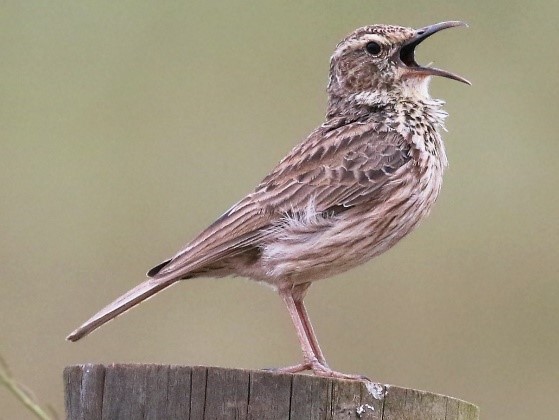AGULHAS LONG-BILLED LARK

Disclaimer: Copyright infringement not intended.
Context
- South Africa’s Agulhas long-billed lark are adapting and surviving despite farming taking over their nesting grounds.
Agulhas Long-billed Lark
- The Agulhas Long-billed Lark (Certhilauda brevirostris) is a bird species native to South Africa, particularly in the southwestern part of the country.
Physical Characteristics:
- The Agulhas Long-billed Lark is a medium-sized bird with a distinct appearance.
- It has a long, slender bill, which is a characteristic feature of this species.
- The plumage of the lark is generally brown and streaked, providing camouflage in its natural habitat.
Habitat:
- This lark is commonly found in a variety of open habitats, including grasslands, and shrublands.
- It predominantly nests in the critically endangered Renosterveld fynbos, a vegetation type characterized by grasses and wild spring flowers.
Distribution:
- The Agulhas Long-billed Lark is endemic to the southwestern part of South Africa, with a range that includes the Western Cape and parts of the Eastern Cape.
Behavior:
- As with many lark species, the Agulhas Long-billed Lark is known for its distinctive and melodious song, often delivered from a conspicuous perch.
Feeding Habits:
- The lark primarily feeds on seeds and insects. Its long bill is adapted for probing into the soil in search of food.
Population:
- Population estimates range from 203,000 to 368,000 individuals.
Conservation Status:
- The conservation status of the Agulhas Long-billed Lark is currently Classified as Near-Threatened on the International Union for Conservation of Nature (IUCN) Red List.
Importance in Ecosystem:
- As a bird species, the Agulhas Long-billed Lark plays a role in the ecosystem by contributing to insect control and seed dispersal, thus influencing the dynamics of its habitat.
Nesting Practices Study:
- Recent research by the University of Cape Town’s FitzPatrick Institute of African Ornithology marked the first study on the nesting practices of the Agulhas Long-billed Lark.
Preference for Renosterveld:
- Approximately 66% of nests were found in Renosterveld patches, emphasizing the lark's preference for this habitat.
- Renosterveld constitutes less than 10% of the landscape, posing conservation challenges.
Factors contributing to Renosterveld fynbos degradation and loss:
Agricultural Expansion:
- Farmland expansion and cultivation encroach on Renosterveld habitat, causing fragmentation and loss.
Urbanization and Infrastructure:
- Rapid urban development clears land for housing and roads, isolating Renosterveld and promoting degradation.
Overgrazing by Livestock:
- Uncontrolled grazing by cattle and sheep leads to soil erosion, reduced vegetation, and ecosystem imbalances.
Invasive Species:
- Spread of invasive plants competes with native vegetation, altering plant communities and disrupting the ecological balance.
Fire Mismanagement:
- Inappropriate fire practices disrupt natural regeneration, harming Renosterveld vegetation.
Mining Activities:
- Mining operations cause habitat destruction and fragmentation, impacting the integrity of Renosterveld.
Climate Change:
- Climate influences, though not direct causes, exacerbate existing threats and may impact Renosterveld viability.
Conservation Needs:
- Protection of remaining Renosterveld patches is critical for the survival of the Agulhas Long-billed Lark.
- Natural vegetation growth should be encouraged to increase the size of Renosterveld patches.
- Fire management in Renosterveld is essential, with burning avoided during the larks' peak nesting time (August to November).
Long-Term Conservation Strategies:
- Conservation efforts should focus on preserving not only the Agulhas Long-billed Lark but also other species dependent on Renosterveld.
- Further research is needed to understand predator dynamics in the Renosterveld and improve conservation strategies.
- Balancing short-term losses with long-term survival strategies, considering the larks' reasonably long lifespan (up to 13 years).
|
PRACTICE QUESTION Q. Consider the following statements: 1. The Agulhas Long-billed Lark is a bird species native to Egypt. 2. It predominantly nests in a vegetation type called Renosterveld fynbos. 3. The Agulhas Long-billed Lark is currently Classified as critically endangered on the International Union for Conservation of Nature (IUCN) Red List. How many of the above statements are correct? A. Only 1 B. Only 2 C. All D. None Answer: A. Only 1 Explanation: Statement 1 is incorrect. The Agulhas Long-billed Lark is not native to Egypt; it is native to South Africa, particularly in the southwestern part of the country. Statement 2 is correct. The Agulhas Long-billed Lark predominantly nests in a critically endangered vegetation type called Renosterveld fynbos. Statement 3 is incorrect. The Agulhas Long-billed Lark is currently classified as "Near-Threatened" on the International Union for Conservation of Nature (IUCN) Red List, not "Critically Endangered." |




1.png)
